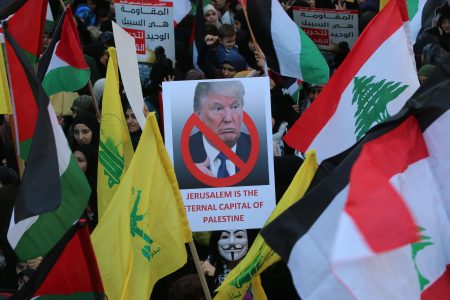
Is Hezbollah now the most prominent threat to the United States?
After the killing of Major General Qassem Suleimani, the loudest voice, after Ayatollah Khamenei, threatening the United States came from Hezbollah. Secretary General of Hezbollah Sheik Hassan Nasrallah in his public speech said that the US military in the Middle East would pay the price for the killing of Iranian General Qassem Soleimani, warning that American soldiers and officers would return home in coffins.
Nasrallah even said that responding to the killing was not only Iran’s responsibility but the responsibility of its allies too. It shows that Hezbollah will take its own revenge as well.
Founded by Iran’s Revolutionary Guards in 1982, the Lebanese group Hezbollah is a critical part of an Iranian so-called “Axis of Resistance”. Some analysts even believe that it is an extension of the Iranian Revolutionary Guards and takes direct orders from Tehran.
Taking revenge for Soleimani’s killing is not about pleasing Iran; for Hezbollah, it is also a personal loss. As the primary architect of Iran’s strategic efforts to promote its expansion and undermine US influence, Soleimani was particularly loved by the Hezbollah.
One thing is evident that the Hezbollah does not make empty threats. It has killed the highest number of Americans after the al-Qaeda. In October 1983, Hezbollah carried out a suicide bombing, killing 241 US servicemen, as it destroyed the US Marine headquarters in Beirut. That was the biggest terrorist attack on the US before 9/11.
If you see the track record of Hezbollah, it has always retaliated to the killings of its leaders and senior cadres. In 1992, Sheikh Abbas Mosai, the then secretary-general of Hezbollah, was assassinated by Israelis in an airstrike. Mosai was a revered figure among Hezbollah’s cadres, and his death was a major blow to the organisation’s morale. Initially, it appeared that Israel had scored a major achievement in finishing its Lebanese enemy. But a month after Musawi’s assassination, a vehicle-borne suicide bomber attacked the Israeli embassy in Buenos Aires, killing 29 people and wounding more than 200. The message was loud and clear that revenge would be taken and that they have the capability to attack Israeli interests around the world. In 1992, the then relatively small Hezbollah was able to exact vengeance against Israel for Musawi’s death in South America, far from the Middle East.
Now a much stronger Hezbollah would definitely try to attack the United States forces and interests spread across the Middle East. Hezbollah has been preparing for this day for decades, building up military, terrorist and cyber capabilities in Lebanon and the Middle East, in order to strike back at the United States and anyone else who might threaten Iran.
The Iranian missile attack on two Iraqi bases that host US forces was Tehran’s initial, symbolic and overt response to Soleimani’s death. Iran’s full response would unfold in the coming months and years and woulddefinitely feature Hezbollah in a starring role. Iran cannot afford a full-fledged conventional conflict with the United States as itwould be bound to lose that. The best way to bleed the US is through its most potent proxy: Hezbollah. Any asymmetric attack by a proxy would be covert and could always be denied.
The United States has troops currently staged throughout the Middle East and the Persian Gulf, including in Iraq, Syria, Qatar, Bahrain, Kuwait and the United Arab Emirates. With so many targets to choose from, Hezbollah can attack at a place of its choice. In Iraq, America still has 5,000 troops and Hezbollah has its Unit 3800, which spearheaded arming and training the Shiite militias that may soon launch a bloody insurgency against American forces.
To counter this potent threat to the security of US forces and interests in the region, a comprehensive hybrid strategy is required that includes both defensive and offensive measures. Defensively, the US should ensure greater security cover for all its bases in the region, and even the host countries should be requested to provide greater security to US embassies and consulates. In the offensive strategy, focus should be on eroding the military capabilities of Hezbollah by attacking its arms shipments, arms depots and senior operatives.
Military pressure should be built up in the core territory of Hezbollah, which is the South Lebanon, so that Hezbollah gets busy in defending itself rather than attacking the US.
American policy makers should not differentiate between Iran and Hezbollah as they are one entity. A joint strategy should be formulated to curtail Iran and Hezbollah simultaneously.
Source: Daily Times





